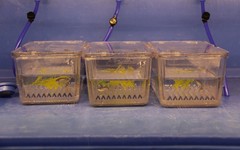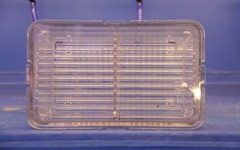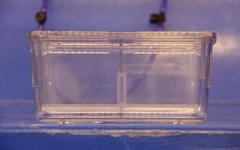Social behaviour
Zebrafish are social, shoaling animals. Aggression among them takes the form of chasing and sometimes “biting”. Aggression can occur among females only, males only, and between males and females. Aggression is associated with both reproduction and dominance.
Social isolation
Long-term social isolation has a negative impact on welfare and health. When fish must be housed in long-term isolation for experimental or other reasons, consider providing social stimuli by enabling visual contact with conspecifics or pictures/videos of conspecifics, or by housing the fish together with a “companion fish” from a distinctly different line for easy recognition.
Dominance
Because the species displays territorial and dominance-related aggression, it is important to keep a close eye on the composition and density of zebrafish groups. Dominant fish can monopolize enrichment materials, or “claim” certain tank areas: swimming mostly in the upper water column or crisscrossing the entire tank. Submissive animals, in contrast, can develop signs of chronic stress.
Reproduction
The reproductive success of matings is affected by a number of factors:
- Aggression between males and females;
- The ratio of males to females in the holding tank;
- Any released female pheromones and partner preferences.
Furthermore, breeding success may vary depending on the zebrafish line. Males and females are separated overnight and allowed to mate in the morning. This happens in special spawning tanks (see figure 1). The males fertilize eggs that have just been deposited by the female. The eggs sink to the bottom from where they can be harvested. There is no parental care.
Figure 1 shows spawning tanks, in which males and females (here seen in the foreground) can be separated overnight. Different ratios can be used, e.g. 1 male to 1 female, or 2 males to 1 female. On the female side, a plastic plant provides enrichment. In the morning, the tank divider is removed, the water replenished and the insert is placed in a slanted position; this provides a shallow area, which is what females prefer to deposit their eggs. The tank bottom is corrugated and the eggs sink into the deep grooves where they cannot be cannibalized. Factors that stimulate oviposition are changing the temperature or conductivity of the water and increasing the intensity of the light (“dawn”). Figure 2 shows the top view of a spawning tank, figure 3 shows the side view.
Housing of eggs
Eggs are “housed” in petri dishes filled with E3 growth medium. At a temperature of 28-28.5 degrees and a day-night cycle of 14 hours of light to 10 hours of darkness (14L:10D), the eggs will hatch within 48 to 72 hours. The density guideline at this temperature is 50 eggs per petri dish. A 14L:10D day-night cycle is preferred to continuous light or darkness, because under unnatural lighting conditions, the risk of developmental abnormalities is increased.



